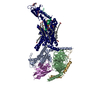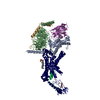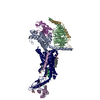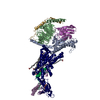+ Open data
Open data
- Basic information
Basic information
| Entry | Database: PDB / ID: 7tzf | |||||||||||||||||||||||||||||||||||||||||||||||||||||||||||||||||||||||||||||||||||||||||||||||||||
|---|---|---|---|---|---|---|---|---|---|---|---|---|---|---|---|---|---|---|---|---|---|---|---|---|---|---|---|---|---|---|---|---|---|---|---|---|---|---|---|---|---|---|---|---|---|---|---|---|---|---|---|---|---|---|---|---|---|---|---|---|---|---|---|---|---|---|---|---|---|---|---|---|---|---|---|---|---|---|---|---|---|---|---|---|---|---|---|---|---|---|---|---|---|---|---|---|---|---|---|---|
| Title | Human Amylin3 Receptor in complex with Gs and rat amylin peptide | |||||||||||||||||||||||||||||||||||||||||||||||||||||||||||||||||||||||||||||||||||||||||||||||||||
 Components Components |
| |||||||||||||||||||||||||||||||||||||||||||||||||||||||||||||||||||||||||||||||||||||||||||||||||||
 Keywords Keywords | MEMBRANE PROTEIN / Amylin receptor / GPCR / RAMP3 / rat amylin | |||||||||||||||||||||||||||||||||||||||||||||||||||||||||||||||||||||||||||||||||||||||||||||||||||
| Function / homology |  Function and homology information Function and homology informationCalcitonin-like ligand receptors / cross-receptor inhibition within G protein-coupled receptor heterodimer / G protein-coupled receptor signaling pathway involved in heart process / adrenomedullin receptor activity / adrenomedullin receptor complex / adrenomedullin receptor signaling pathway / calcitonin binding / calcitonin family receptor activity / amylin receptor complex 1 / amylin receptor complex 2 ...Calcitonin-like ligand receptors / cross-receptor inhibition within G protein-coupled receptor heterodimer / G protein-coupled receptor signaling pathway involved in heart process / adrenomedullin receptor activity / adrenomedullin receptor complex / adrenomedullin receptor signaling pathway / calcitonin binding / calcitonin family receptor activity / amylin receptor complex 1 / amylin receptor complex 2 / calcitonin family receptor signaling pathway / amylin receptor complex 3 / amylin receptor activity / calcitonin receptor activity / calcitonin gene-related peptide receptor signaling pathway / calcitonin gene-related peptide receptor activity / amylin receptor 3 signaling pathway / amylin receptor 2 signaling pathway / amylin receptor 1 signaling pathway / amylin receptor signaling pathway / Calcitonin-like ligand receptors / negative regulation of ossification / negative regulation of bone resorption / eating behavior / positive regulation of receptor recycling / negative regulation of osteoclast differentiation / response to amyloid-beta / positive regulation of cAMP/PKA signal transduction / PKA activation in glucagon signalling / developmental growth / hair follicle placode formation / D1 dopamine receptor binding / bone resorption / intracellular transport / vascular endothelial cell response to laminar fluid shear stress / response to glucocorticoid / renal water homeostasis / activation of adenylate cyclase activity / cellular response to hormone stimulus / Hedgehog 'off' state / coreceptor activity / adenylate cyclase-activating adrenergic receptor signaling pathway / regulation of mRNA stability / sensory perception of pain / cellular response to glucagon stimulus / regulation of insulin secretion / positive regulation of calcium-mediated signaling / ossification / secretory granule / acrosomal vesicle / osteoclast differentiation / adenylate cyclase activator activity / trans-Golgi network membrane / protein localization to plasma membrane / positive regulation of protein localization to plasma membrane / intracellular protein transport / cellular response to estradiol stimulus / negative regulation of inflammatory response to antigenic stimulus / hormone activity / bone development / receptor internalization / G-protein beta/gamma-subunit complex binding / platelet aggregation / Olfactory Signaling Pathway / cognition / Activation of the phototransduction cascade / G beta:gamma signalling through PLC beta / Presynaptic function of Kainate receptors / Thromboxane signalling through TP receptor / G protein-coupled acetylcholine receptor signaling pathway / G-protein activation / Activation of G protein gated Potassium channels / Inhibition of voltage gated Ca2+ channels via Gbeta/gamma subunits / adenylate cyclase-activating G protein-coupled receptor signaling pathway / glucose metabolic process / Prostacyclin signalling through prostacyclin receptor / G beta:gamma signalling through CDC42 / Glucagon signaling in metabolic regulation / G beta:gamma signalling through BTK / Synthesis, secretion, and inactivation of Glucagon-like Peptide-1 (GLP-1) / ADP signalling through P2Y purinoceptor 12 / Sensory perception of sweet, bitter, and umami (glutamate) taste / photoreceptor disc membrane / Glucagon-type ligand receptors / Adrenaline,noradrenaline inhibits insulin secretion / Vasopressin regulates renal water homeostasis via Aquaporins / calcium ion transport / G alpha (z) signalling events / Glucagon-like Peptide-1 (GLP1) regulates insulin secretion / cellular response to catecholamine stimulus / ADP signalling through P2Y purinoceptor 1 / ADORA2B mediated anti-inflammatory cytokines production / G beta:gamma signalling through PI3Kgamma / sensory perception of smell / Cooperation of PDCL (PhLP1) and TRiC/CCT in G-protein beta folding / adenylate cyclase-activating dopamine receptor signaling pathway / GPER1 signaling / Inactivation, recovery and regulation of the phototransduction cascade / cellular response to prostaglandin E stimulus / G-protein beta-subunit binding Similarity search - Function | |||||||||||||||||||||||||||||||||||||||||||||||||||||||||||||||||||||||||||||||||||||||||||||||||||
| Biological species |  Homo sapiens (human) Homo sapiens (human)  | |||||||||||||||||||||||||||||||||||||||||||||||||||||||||||||||||||||||||||||||||||||||||||||||||||
| Method | ELECTRON MICROSCOPY / single particle reconstruction / cryo EM / Resolution: 2.4 Å | |||||||||||||||||||||||||||||||||||||||||||||||||||||||||||||||||||||||||||||||||||||||||||||||||||
 Authors Authors | Cao, J. / Belousoff, M.J. / Johnson, R.M. / Wootten, D.L. / Sexton, P.M. | |||||||||||||||||||||||||||||||||||||||||||||||||||||||||||||||||||||||||||||||||||||||||||||||||||
| Funding support |  Australia, Australia,  Japan, 7items Japan, 7items
| |||||||||||||||||||||||||||||||||||||||||||||||||||||||||||||||||||||||||||||||||||||||||||||||||||
 Citation Citation |  Journal: Science / Year: 2022 Journal: Science / Year: 2022Title: A structural basis for amylin receptor phenotype. Authors: Jianjun Cao / Matthew J Belousoff / Yi-Lynn Liang / Rachel M Johnson / Tracy M Josephs / Madeleine M Fletcher / Arthur Christopoulos / Debbie L Hay / Radostin Danev / Denise Wootten / Patrick M Sexton /    Abstract: Amylin receptors (AMYRs) are heterodimers of the calcitonin (CT) receptor (CTR) and one of three receptor activity-modifying proteins (RAMPs), AMYR, AMYR, and AMYR. Selective AMYR agonists and dual ...Amylin receptors (AMYRs) are heterodimers of the calcitonin (CT) receptor (CTR) and one of three receptor activity-modifying proteins (RAMPs), AMYR, AMYR, and AMYR. Selective AMYR agonists and dual AMYR/CTR agonists are being developed as obesity treatments; however, the molecular basis for peptide binding and selectivity is unknown. We determined the structure and dynamics of active AMYRs with amylin, AMYR with salmon CT (sCT), AMYR with sCT or human CT (hCT), and CTR with amylin, sCT, or hCT. The conformation of amylin-bound complexes was similar for all AMYRs, constrained by the RAMP, and an ordered midpeptide motif that we call the bypass motif. The CT-bound AMYR complexes were distinct, overlapping the CT-bound CTR complexes. Our findings indicate that activation of AMYRs by CT-based peptides is distinct from their activation by amylin-based peptides. This has important implications for the development of AMYR therapeutics. | |||||||||||||||||||||||||||||||||||||||||||||||||||||||||||||||||||||||||||||||||||||||||||||||||||
| History |
|
- Structure visualization
Structure visualization
| Structure viewer | Molecule:  Molmil Molmil Jmol/JSmol Jmol/JSmol |
|---|
- Downloads & links
Downloads & links
- Download
Download
| PDBx/mmCIF format |  7tzf.cif.gz 7tzf.cif.gz | 256.8 KB | Display |  PDBx/mmCIF format PDBx/mmCIF format |
|---|---|---|---|---|
| PDB format |  pdb7tzf.ent.gz pdb7tzf.ent.gz | 193.5 KB | Display |  PDB format PDB format |
| PDBx/mmJSON format |  7tzf.json.gz 7tzf.json.gz | Tree view |  PDBx/mmJSON format PDBx/mmJSON format | |
| Others |  Other downloads Other downloads |
-Validation report
| Summary document |  7tzf_validation.pdf.gz 7tzf_validation.pdf.gz | 1.7 MB | Display |  wwPDB validaton report wwPDB validaton report |
|---|---|---|---|---|
| Full document |  7tzf_full_validation.pdf.gz 7tzf_full_validation.pdf.gz | 1.7 MB | Display | |
| Data in XML |  7tzf_validation.xml.gz 7tzf_validation.xml.gz | 52.4 KB | Display | |
| Data in CIF |  7tzf_validation.cif.gz 7tzf_validation.cif.gz | 79.2 KB | Display | |
| Arichive directory |  https://data.pdbj.org/pub/pdb/validation_reports/tz/7tzf https://data.pdbj.org/pub/pdb/validation_reports/tz/7tzf ftp://data.pdbj.org/pub/pdb/validation_reports/tz/7tzf ftp://data.pdbj.org/pub/pdb/validation_reports/tz/7tzf | HTTPS FTP |
-Related structure data
| Related structure data |  26208MC  7tyfC  7tyhC  7tyiC  7tylC  7tynC  7tyoC  7tywC  7tyxC  7tyyC M: map data used to model this data C: citing same article ( |
|---|---|
| Similar structure data | Similarity search - Function & homology  F&H Search F&H Search |
- Links
Links
- Assembly
Assembly
| Deposited unit | 
|
|---|---|
| 1 |
|
- Components
Components
-Protein , 2 types, 2 molecules ER
| #1: Protein | Mass: 16896.650 Da / Num. of mol.: 1 Source method: isolated from a genetically manipulated source Source: (gene. exp.)  Homo sapiens (human) / Gene: RAMP3 / Production host: Homo sapiens (human) / Gene: RAMP3 / Production host:  Trichoplusia ni (cabbage looper) / References: UniProt: O60896 Trichoplusia ni (cabbage looper) / References: UniProt: O60896 |
|---|---|
| #3: Protein | Mass: 58469.594 Da / Num. of mol.: 1 Source method: isolated from a genetically manipulated source Source: (gene. exp.)  Homo sapiens (human) / Gene: CALCR / Production host: Homo sapiens (human) / Gene: CALCR / Production host:  Trichoplusia ni (cabbage looper) / References: UniProt: P30988 Trichoplusia ni (cabbage looper) / References: UniProt: P30988 |
-Guanine nucleotide-binding protein ... , 3 types, 3 molecules ABG
| #4: Protein | Mass: 45699.434 Da / Num. of mol.: 1 Source method: isolated from a genetically manipulated source Source: (gene. exp.)  Homo sapiens (human) / Gene: GNAS, GNAS1, GSP / Production host: Homo sapiens (human) / Gene: GNAS, GNAS1, GSP / Production host:  Trichoplusia ni (cabbage looper) / References: UniProt: P63092 Trichoplusia ni (cabbage looper) / References: UniProt: P63092 |
|---|---|
| #5: Protein | Mass: 38534.062 Da / Num. of mol.: 1 Source method: isolated from a genetically manipulated source Source: (gene. exp.)  Homo sapiens (human) / Gene: GNB1 / Production host: Homo sapiens (human) / Gene: GNB1 / Production host:  Trichoplusia ni (cabbage looper) / References: UniProt: P62873 Trichoplusia ni (cabbage looper) / References: UniProt: P62873 |
| #6: Protein | Mass: 7861.143 Da / Num. of mol.: 1 Source method: isolated from a genetically manipulated source Source: (gene. exp.)  Homo sapiens (human) / Gene: GNG2 / Production host: Homo sapiens (human) / Gene: GNG2 / Production host:  Trichoplusia ni (cabbage looper) / References: UniProt: P59768 Trichoplusia ni (cabbage looper) / References: UniProt: P59768 |
-Protein/peptide / Antibody / Sugars , 3 types, 6 molecules PN

| #2: Protein/peptide | Mass: 3924.426 Da / Num. of mol.: 1 / Fragment: UNP residues 38-74 / Source method: obtained synthetically / Source: (synth.)  |
|---|---|
| #7: Antibody | Mass: 15140.742 Da / Num. of mol.: 1 Source method: isolated from a genetically manipulated source Source: (gene. exp.)   |
| #8: Sugar | ChemComp-NAG / |
-Non-polymers , 4 types, 39 molecules 






| #9: Chemical | ChemComp-P42 / ( | ||||
|---|---|---|---|---|---|
| #10: Chemical | ChemComp-PLM / #11: Chemical | #12: Water | ChemComp-HOH / | |
-Details
| Has ligand of interest | Y |
|---|---|
| Has protein modification | Y |
-Experimental details
-Experiment
| Experiment | Method: ELECTRON MICROSCOPY |
|---|---|
| EM experiment | Aggregation state: PARTICLE / 3D reconstruction method: single particle reconstruction |
- Sample preparation
Sample preparation
| Component | Name: Human Amylin 3 Receptor in complex with Gs and rat amylin peptide Type: COMPLEX / Entity ID: #1-#7 / Source: MULTIPLE SOURCES |
|---|---|
| Molecular weight | Experimental value: NO |
| Buffer solution | pH: 7.4 |
| Specimen | Conc.: 4 mg/ml / Embedding applied: NO / Shadowing applied: NO / Staining applied: NO / Vitrification applied: YES |
| Vitrification | Cryogen name: ETHANE |
- Electron microscopy imaging
Electron microscopy imaging
| Experimental equipment |  Model: Titan Krios / Image courtesy: FEI Company |
|---|---|
| Microscopy | Model: TFS KRIOS |
| Electron gun | Electron source:  FIELD EMISSION GUN / Accelerating voltage: 300 kV / Illumination mode: FLOOD BEAM FIELD EMISSION GUN / Accelerating voltage: 300 kV / Illumination mode: FLOOD BEAM |
| Electron lens | Mode: BRIGHT FIELD / Nominal defocus max: 1500 nm / Nominal defocus min: 500 nm |
| Image recording | Electron dose: 52.8 e/Å2 / Film or detector model: GATAN K3 BIOQUANTUM (6k x 4k) |
- Processing
Processing
| Software | Name: PHENIX / Version: 1.17_3644: / Classification: refinement | ||||||||||||||||||||||||
|---|---|---|---|---|---|---|---|---|---|---|---|---|---|---|---|---|---|---|---|---|---|---|---|---|---|
| EM software | Name: PHENIX / Category: model refinement | ||||||||||||||||||||||||
| CTF correction | Type: PHASE FLIPPING AND AMPLITUDE CORRECTION | ||||||||||||||||||||||||
| Symmetry | Point symmetry: C1 (asymmetric) | ||||||||||||||||||||||||
| 3D reconstruction | Resolution: 2.4 Å / Resolution method: FSC 0.143 CUT-OFF / Num. of particles: 125000 / Symmetry type: POINT | ||||||||||||||||||||||||
| Refine LS restraints |
|
 Movie
Movie Controller
Controller












 PDBj
PDBj


























